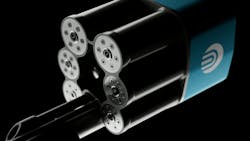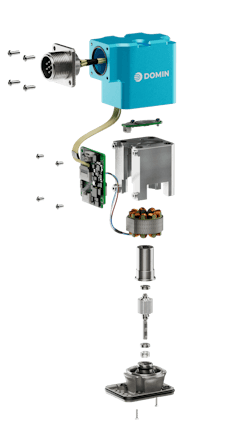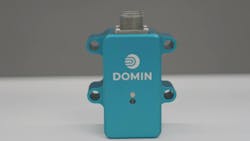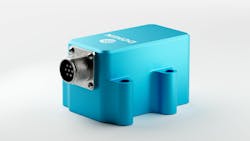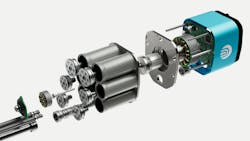Modernizing Hydraulic Systems Through New Technology Developments
Hydraulic systems are an important form of motion control in a range of applications and will remain so due in large part to the energy density they can provide. But according to a recently published white paper from hydraulics developer Domin, these systems have become somewhat stagnant in terms of technological advancements, leading to inefficiencies.
The report cites a study published in the Journal of Engineering showing hydraulic systems can waste up to 70% of the input energy due to inefficiencies. Another study from Oak Ridge National Laboratories cited in the report indicates most systems only achieve 22% efficiency.
“Within the world of hydraulics, we haven't really seen any technology innovation for [about] 70 years now, and there hasn't quite been any new technology that allowed the industry to take a step forward,” said Marcus Pont, CEO of Domin and author of the white paper, in an interview with Power & Motion.
However, the company sees integration of modern technologies such as metal 3D printing, advanced motors, sensors, and cutting-edge control algorithms as a means of progressing hydraulic systems to meet evolving vehicle and machine design requirements.
Doing so for its own hydraulic valve designs has enabled Domin to create components which provide improved control capabilities in a compact package.
How Domin is Applying Modern Technologies to Hydraulic Valves
Domin’s direct-drive hydraulic servo valves make use of two technological innovations by the company:
- the ability to control hydraulic fluid very precisely and accurately at high speeds
- a compact and intelligent hydraulic energy generation system.
According to Pont, these were made possible when the company came across metal 3D printing (also called additive manufacturing) as it provided the opportunity to “rethink how we do everything within hydraulics.”
He explained that hydraulics want smooth, organic structures that help transfer fluid. These can be better achieved with 3D printing as it allows for creation of different geometries typically not possible with traditional manufacturing. Domin’s standard S6 Pro valve, for instance, features spiraling galleries within the valve to increase the flow of hydraulic fluid as a more curved internal architecture better aids fluid travel.
In addition, 3D printing allows for more integrated components to be created and less material used, leading to lighter weight and more compact designs.
He said using more modern approaches to electric motors, sensing and simulation aided development of the company’s hydraulic valves as well. Onboard electronics enable digital control for improved control capabilities along with data collection, communication and remote monitoring functionalities.
Inclusion of brushless DC motors enables smooth and controlled valve adjustments while magnetic position sensing allows for the spool position to be adjusted in less than 3 milliseconds.
Additive Manufacturing Allows for Custom Hydraulic Valve Design
Use of 3D printing enables Domin to customize its hydraulic valves as well said Pont. This was the case when working with the INEOS Britannia team as it looked to improve the performance of its racing yacht that would be used in the 2024 America’s Cup. The team saw an opportunity to do so through improved control of the boat's hydraulics.
According to Pont, the team was looking for a hydraulic technology that offered a high level of precision yet was energy efficient and small, all while operating at high pressures. These can often be competing attributes though.
“You can have [components] that are small and precise but as you start to increase the pressure, sometimes that efficiency and ability to control with precision gets ever harder because the forces [increase],” he explained. “[For the] efficiency piece, as the pressure increases, you’re more likely to get losses through any of the small leak paths within a product.”
When the INEOS Britannia reached out to Domin to see if it had a product that would meet its requirements, Pont said the company began investigating the potential of using its S6 Pro valve. Although baseline testing showed promising results, the yacht racing team challenged Domin to customize the valve so it could operate at higher pressures while improving efficiency by about 90%.
Domin was able to meet the team’s requirements through the use of metal 3D printing by applying “a degree of customization to effectively increase its pressure rating,” said Pont.
In addition, he said the company used advanced simulation techniques, particularly those associated with finite element analysis and stress analysis, in conjunction with computational fluid dynamics to adapt the hydraulic system’s manifold and controls to handle the higher pressures required by the INEOS Britannia team.
“These are pressures beyond almost anything else that we've experienced in any other industry, and they have to last [infinitely],” he said. “It was through the ability to do stress analysis, iterate quickly with 3D printing, tests and feedback that we were able to [achieve those pressures].”
Changes to the software that controls the hydraulic valve used in this application were necessary as well to enable all components to work within a higher pressure environment while also enabling the high speed and precision desired by the INEOS Britannia team.
Watch our video interview below with Marcus Pont of Domin to learn more about the project with INEOS Britannia.
Demand for Higher Pressures and Smaller Systems Requires a Rethinking of Hydraulics
Pont said one of the major benefits of the hydraulic valve product developed through the INEOS Britannia partnership is that it demonstrates the ability to run the whole hydraulic system at a higher pressure.
Many industries, from aerospace to industrial, are moving toward increased pressures for hydraulic systems, he said. “If you can manage the higher pressure, you almost get power density for free,” he explained.
In aerospace, Pont said it has become unusual to see a hydraulic system under 5,000 psi (345 bar) at this point. “We’re starting to see more people demand that increase in pressure.”
And when you run a system at higher pressures he said “you can shrink everything. You can shrink the hydraulic lines around the system, the size of the actuators that are moving the system [and] the manifold.”
Reducing the size of the hydraulic system can improve efficiency while also helping reduce overall machine weight and size, leading to benefits such as reductions in material and energy use.
Pont said people are looking to get more functionality from their machines, both mobile and stationary, but without increasing their size. And the only way to achieve that is to make the components smaller, he said. Using higher pressure systems enables this.
Like many others in the fluid power industry, Pont also sees the use of decentralized systems as a means of overcoming some the current challenges associated with hydraulics. Domin has developed a radial piston pump technology that can help achieve such system architectures, he said.
Typically, a hydraulic pump sits at the center of a vehicle or machine with hoses and other components connected to it that run throughout the structure. The Domin radial piston pump, on the other hand, enables a more integrated approach to create a decentralized system. “We can combine this radial piston pump with our valve technology, and we can put within that the accumulators and reservoirs we need to manage the oil and have it locally connected to the place where the movement's required,” explained Pont.
“We think the future of hydraulics is going to be a decentralized system where we're able to actually offer all the benefits that hydraulics brings — energy density, the ability to run things efficiently — but without some of the downsides that come through managing huge systems that require a lot of assembly time, are heavier, and require higher maintenance,” he said.
“That's really the trend that we see coming in the industry, moving towards electrohydrostatic actuation,” he continued. “Going back to first principles in engineering, using metal 3D printing and the advanced control and advanced sensors that we’re bringing forward really allows us to deliver that electrohydrostatic control in a way that's significantly better than what exists today.”
Electrohydrostatic actuation is said to bring together the best of hydraulic and electromechanical technologies by providing the high forces offered by hydraulics with the energy efficiency of electromechanical.
Pont said industries are looking for ways to use energy in a more intelligent manner, especially as they move further toward electrification, which electrohydrostatic actuation can provide. He believes that in the next 10 years hydraulic systems will look almost unrecognizable due to all the advancements likely to occur in the coming years.
By moving to a decentralized system and electrohydrostatic actuation, he said it will provide the opportunity to deliver electrification at the vehicle level without having to use it at the actuation level.
“We don't think that the industry really cares whether the actuation is hydraulic or electric, just that the vehicle's electric. And we think that this is the opportunity to finally deliver electrification whilst maintaining the benefits of hydraulics.
“The benefits of hydraulics [are] here to stay, they just need to be delivered in a way that suits the modern world. We're still using the hydraulic systems from the 20th century, and they're competing with electromechanical from the 21st century. And we need to bring the hydraulics technology into the 21st century so that it can fit along the systems and the vehicles in the way that they exist today,” concluded Pont.
About the Author
Sara Jensen
Executive Editor, Power & Motion
Sara Jensen is executive editor of Power & Motion, directing expanded coverage into the modern fluid power space, as well as mechatronic and smart technologies. She has over 15 years of publishing experience. Prior to Power & Motion she spent 11 years with a trade publication for engineers of heavy-duty equipment, the last 3 of which were as the editor and brand lead. Over the course of her time in the B2B industry, Sara has gained an extensive knowledge of various heavy-duty equipment industries — including construction, agriculture, mining and on-road trucks —along with the systems and market trends which impact them such as fluid power and electronic motion control technologies.
You can follow Sara and Power & Motion via the following social media handles:
X (formerly Twitter): @TechnlgyEditor and @PowerMotionTech
LinkedIn: @SaraJensen and @Power&Motion
Facebook: @PowerMotionTech

Leaders relevant to this article:
